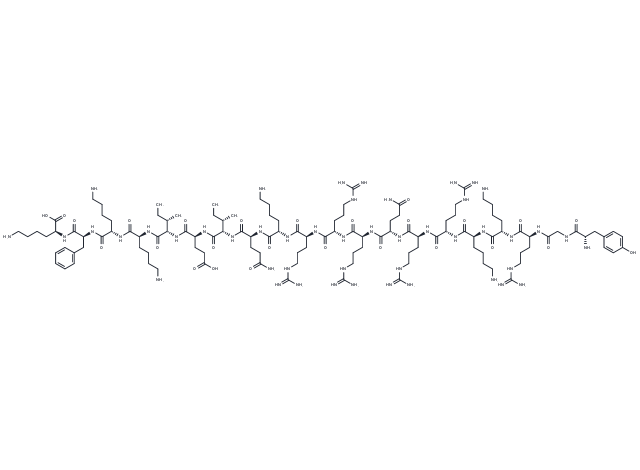Shopping Cart
- Remove All
 Your shopping cart is currently empty
Your shopping cart is currently empty

TAT-Gap19 acetate is a specific inhibitor of connexin43 hemichannel (Cx43 HC). TAT-Gap19 acetate traverses the blood-brain barrier and alleviates liver fibrosis in mice. TAT-Gap19 acetate does not inhibit the corresponding Cx43 GJCs.

| Pack Size | Price | Availability | Quantity |
|---|---|---|---|
| 1 mg | $58 | In Stock | |
| 5 mg | $118 | In Stock | |
| 10 mg | $203 | In Stock | |
| 25 mg | $358 | In Stock | |
| 50 mg | $511 | In Stock | |
| 100 mg | $702 | In Stock | |
| 200 mg | $946 | In Stock |
| Description | TAT-Gap19 acetate is a specific inhibitor of connexin43 hemichannel (Cx43 HC). TAT-Gap19 acetate traverses the blood-brain barrier and alleviates liver fibrosis in mice. TAT-Gap19 acetate does not inhibit the corresponding Cx43 GJCs. |
| In vivo | TAT-Gap19 acetate (1 mg/kg/day) showed significantly decreased collagen deposition, as well as lower amounts of α-SMA-positive cells area in mice subjected to treatment with 100-200 mg thioacetamide (TAA)/kg body weight for eight weeks[1]. In 4 months old C57Bl6 male mice, TAT-Gap19 acetate (i.v.; 55 mg/kg) produces significant immune signal in the brain 24 h later[2]. |
| Molecular Weight | 2703.25 |
| Formula | C119H212N46O26 |
| Smiles | CC[C@H](C)[C@@H](C(N[C@@H](CCCCN)C(N[C@@H](CCCCN)C(N[C@@H](Cc1ccccc1)C(N[C@@H](CCCCN)C(O)=O)=O)=O)=O)=O)NC([C@H](CCC(O)=O)NC([C@H]([C@@H](C)CC)NC([C@H](CCC(N)=O)NC([C@H](CCCCN)NC([C@H](CCCNC(N)=N)NC([C@H](CCCNC(N)=N)NC([C@H](CCCNC(N)=N)NC([C@H](CCC(N)=O)NC([C@H](CCCNC(N)=N)NC([C@H](CCCNC(N)=N)NC([C@H](CCCCN)NC([C@H](CCCCN)NC([C@H](CCCNC(N)=N)NC(CNC([C@H](Cc(cc1)ccc1O)N)=O)=O)=O)=O)=O)=O)=O)=O)=O)=O)=O)=O)=O)=O)=O |
| Relative Density. | no data available |
| Storage | keep away from moisture | Powder: -20°C for 3 years | In solvent: -80°C for 1 year | Shipping with blue ice. |

Copyright © 2015-2025 TargetMol Chemicals Inc. All Rights Reserved.